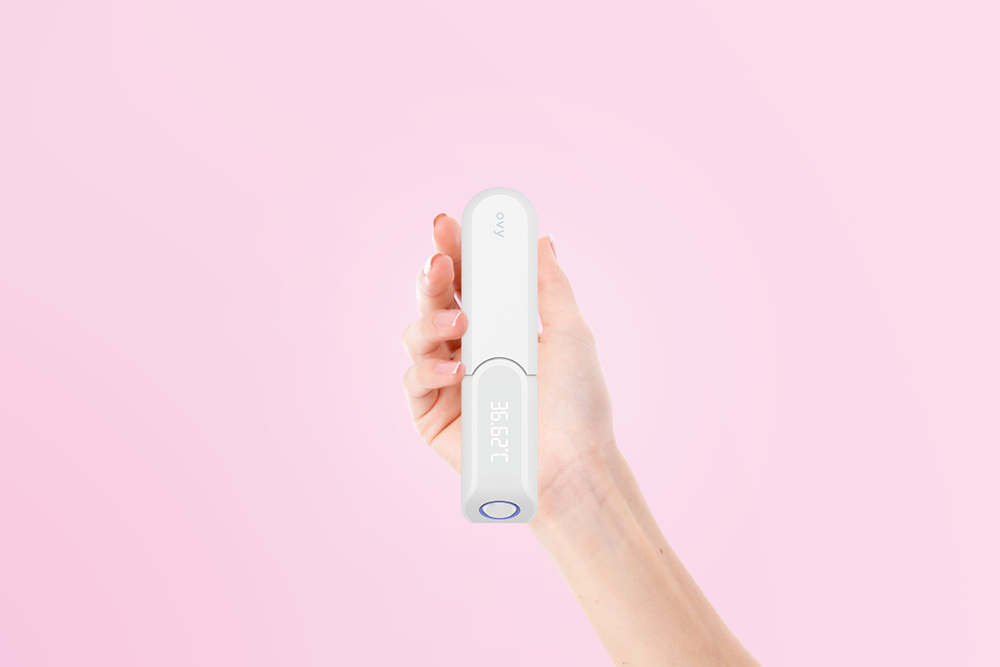Key Takeaways
- The symptothermal method is based on the evaluation of two body signals: The basal body temperature and cervical mucus quality and/or cervix quality.
- Particularly women who have little to no cervical mucus often fall back on the cervix as a second body signal.
- In this article you will learn everything you need to know about examining and evaluating the cervix and cervical mucus.
In order to conceive naturally using the symptothermal method, there is an additional body signal you need to document alongside your basal body temperature: Cervix or cervical mucus. The combination of two body signals is important for calculating your fertile days in the cycle. If you decide to document your cervix in addition to your basal body temperature, you will need to check it regularly by means of palpation. We explain how it works in this article.
What is the cervix?
The cervix is the entrance to the uterus. It is anatomically located inside the vagina, but outside the cervical canal, which serves as the connection from the uterus to the vagina. The cervical canal is above the cervix, and leads into the uterine cavity. This canal is about 1-4 millimeters wide and has a special mucous membrane that produces cervical mucus just before ovulation. Before fertilization of the egg occurs, the sperm must first pass through the cervix and then through this canal.
What does the cervix say about my fertility?
In the course of the cycle, the opening, position and firmness of the cervix change:
Shortly after menstruation, the cervix is closed, hard and low. It can be easily palpated at this stage.
Around the middle of the cycle, the cervix is less firm, semi-open and sits higher up in the vagina. It is now more difficult to feel than at the beginning of the cycle.
During the fertile days around ovulation, the cervix is soft, high, open and quite difficult to feel, as it is then very high up in the vagina. This is because the tissue absorbs water, softens and moves deeper into the vagina as estrogen levels rise. This is the stage in which conditions are optimal for the reception of sperm and fertilization of the egg. The vagina is correspondingly wet, and a clear, permeable cervical mucus will appear, which favors the path of the sperm to the egg.
Once ovulation is complete, the cervix hardens again at the end of the cycle. It closes and will be easier to reach with a finger due to its lower position in the vagina.
How exactly do I palpate the cervix?
During self-examination of the cervix, you check the firmness, position and degree of opening and document these factors in the Ovy App. Where exactly you should enter the changes is explained below.
We recommend you start palpation immediately after menstrual bleeding has come to an end. You should wash your hands thoroughly before performing palpation. It is best to always check the cervix in the same position. For example, from a squatting position. This makes the cervix easier to feel. The position you choose for palpation is up to you. Some women like to palpate their cervix lying down, others put one leg on the toilet - try different positions until you find the one that suits you.
You can feel the cervix at the end of the vagina by inserting one or two fingers. For some women, the cervix is located further forward, for others further back towards the coccyx. Since all bodies are different, the size also varies. On average, the cervix is cherry-sized, or about 1.5–3 centimeters in diameter. The consistency can be compared to the ball of the thumb. The cervix feels like a dimple and ideally, you can even feel an enlargement of this dimple with your fingertip. This is the opening of the cervix.
Why can't I feel a difference right away?
Changes in the opening of the cervix are in the millimeter range and are associated with varying firmness. The individual differences in the palpation of the cervix can be large (depth of the vagina, length of the finger, etc.). You may also not be able to feel anything right away. Again, with a little practice and patience, you will get better and better at classifying the changes in your body signals.
How do I document the cervix in the Ovy App?
In the Ovy App, you'll find the following parameters which you can set:
Opening:
Closed
Partially open
Fully open
The opening of the uterus is taken into account when calculating your fertile days.
Firmness:
Hard
Soft
The firmness of the uterus is taken into account when calculating your fertile days.
Location:
Low
Medium
High
The position of your uterus is not included in the calculation and is only used for documentation purposes.
Should I document cervical mucus or cervix instead?
Which of the two body signals you document in addition to the basal body temperature in the Ovy App is up to you. Similar to the cervix, the cervical mucus also changes in the course of the cycle. If your body produces little or hardly any cervical mucus, you also have the option of monitoring the cervix itself instead of the cervical mucus. However, if you produce enough cervical mucus and are more confident about checking its consistency and quantity daily than palpating the cervix, cervical mucus may be the easier alternative.
You can also combine palpation of the cervix with testing the cervical mucus. If cervical mucus sticks to your fingertip, you can check it for quantity and consistency.
Does it make a difference if I have already given birth?
For women who have already given birth, the cervix may never be completely closed. For further questions, please consult your gynecologist.
Source: MedlinePlus.gov
References & Literature
- MedlinePlus.gov





